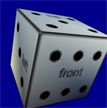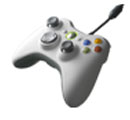
Course 3D_XNA: 3D-Computer Graphics with XNA
Chapter C5: Dice with Texture
Copyright © by V. Miszalok, last update: 25-09-201ß


Let me know
what you think
| Home | Course Index | << Prev. | Next >> | C5 Code Comments | PDF Version of this Page |
 |
Course 3D_XNA: 3D-Computer Graphics with XNA
|
 |
 Let me know what you think |
|
Chapter 5 demonstrates:
- How to write an X-file describing the 6 faces of a dice, describing materials, faces and normals,
- by Vertex Buffer, Index Buffer, MeshMaterialList, MeshTextureCoords and MeshNormals.
- How to arrange and orientate the six faces properly.
- How to load the dice model.
- How to scale, rotate and translate the model via the XBox 360 controller.
- How to draw the model with its six effects.
Chapter 5 doesn't demonstrate:
- How to program light sources.
- How to prevent the camera from penetrating the dice.
 |
Plug Your XBox 360 Controller into an USB-port and check it:
Start → Settings → Gamecontroller → |
1. Main Menu after starting VS 2010:
Solution Explorer - dice1: Delete the file Program.cs and the content of Game1.cs.
2. If You find no Solution Explorer-window, open it via the main menu:
Inside the Solution Explorer-window click + in front of dice1. A tree opens. Look for the branch "References". Click the + in front of References.
Check if there are (among others) these four references:
3.
Right click this link: front.bmp and store it in the project directory C:\temp\dice1\Content.
Right click this link: back.bmp and store it in the project directory C:\temp\dice1\Content.
Right click this link: top.bmp and store it in the project directory C:\temp\dice1\Content.
Right click this link: bottom.bmp and store it in the project directory C:\temp\dice1\Content.
Right click this link: right.bmp and store it in the project directory C:\temp\dice1\Content.
Right click this link: left.bmp and store it in the project directory C:\temp\dice1\Content.
Right click this link: dice.x and store it in the project directory C:\temp\dice1\Content.
4. Now You have to add these six images and the Mesh file to project dice1:
Right click the branch dice1 → Content → Add →
Select the 7 imported files, quit by clicking the Add-button and check whether they arrived underneath the branch dice1 → Content.
5. The 6 images are automatically compiled from *.bmp to *.xnb when dice.x is compiled to dice.xnb. For this reason they should not compile on their own. Change their default Build Action-properties "Compile" to "None".
Write the following code into the empty code window of Game1.cs:
using System;
using Microsoft.Xna.Framework;
using Microsoft.Xna.Framework.Content;
using Microsoft.Xna.Framework.Graphics;
using Microsoft.Xna.Framework.Input;
static class Program
{ [STAThread] static void Main() { Game1 game = new Game1(); game.Run(); }
public class Game1 : Game
{ private GraphicsDeviceManager g;
private ContentManager content;
private Model model;
private Matrix world, view, proj;
private float positionX = 0.0f, positionY = 0.0f, positionZ = 0.0f;
private float scaleX = 1.0f, scaleY = 1.0f, scaleZ = 1.0f;
private float rotationX = 0.5f, rotationY = 0.5f, rotationZ = 0.0f;
public Game1()
{ g = new GraphicsDeviceManager( this );
content = new ContentManager( Services );
}
protected override void Initialize()
{ g.PreferredBackBufferWidth = 400;
g.PreferredBackBufferHeight = 400;
g.ApplyChanges();
Window.Title = "Dice";
g.IsFullScreen = false;
Window.AllowUserResizing = true;
base.Initialize();
}
protected override void LoadContent()
{ model = content.Load< Model >( "Content\\dice" );
}
protected override void UnloadContent()
{ content.Unload();
}
protected override void Update( GameTime gameTime )
{ GamePadState s = GamePad.GetState( PlayerIndex.One );
if ( !s.IsConnected ) Exit();
Vector2 ts = s.ThumbSticks.Left;
rotationY += 0.05f * ts.X;
rotationX -= 0.05f * ts.Y;
ts = s.ThumbSticks.Right;
rotationY += 0.05f * ts.X;
positionZ -= 0.1f * ts.Y;
if ( s.DPad.Left == ButtonState.Pressed ) positionX -= 0.05f;
if ( s.DPad.Right == ButtonState.Pressed ) positionX += 0.05f;
if ( s.DPad.Up == ButtonState.Pressed ) positionY += 0.05f;
if ( s.DPad.Down == ButtonState.Pressed ) positionY -= 0.05f;
if ( s.Buttons.Y == ButtonState.Pressed ) scaleY *= 1.01f;
if ( s.Buttons.A == ButtonState.Pressed ) scaleY *= 0.99f;
if ( s.Buttons.X == ButtonState.Pressed ) scaleX *= 0.99f;
if ( s.Buttons.B == ButtonState.Pressed ) scaleX *= 1.01f;
if ( s.Buttons.Back == ButtonState.Pressed )
{ positionX = positionY = positionZ = 0.0f;
scaleX = scaleY = scaleZ = 1.0f;
rotationX = rotationY = rotationZ = 0.0f;
}
world = Matrix.CreateScale( scaleX, scaleY, scaleZ ) *
Matrix.CreateRotationX( rotationX ) *
Matrix.CreateRotationY( rotationY ) *
Matrix.CreateRotationZ( rotationZ ) *
Matrix.CreateTranslation( positionX, positionY, positionZ );
view = Matrix.CreateLookAt( new Vector3(0f, 0f, 4f), Vector3.Zero, Vector3.Up );
proj = Matrix.CreatePerspectiveFieldOfView( MathHelper.Pi/4, 1f, 0.1f, 200f );
g.GraphicsDevice.RenderState.CullMode = CullMode.None;
base.Update( gameTime );
}
protected override void Draw( GameTime gameTime )
{ g.GraphicsDevice.Clear( Color.DarkBlue );
foreach ( BasicEffect effect in model.Meshes[0].Effects )
{ effect.EnableDefaultLighting();
effect.World = world;
effect.View = view;
effect.Projection = proj;
model.Meshes[0].Draw();
}
}
} // end of class Game1
} // end of class Program
Debug → Start Without Debugging.
Try out both ThumbSticks, the DPad and the buttons Y, A, X, B and Back.
It's surprisingly complicated to write an x-File for a textured box.
The main problems are:
1) A textured box needs 24 vertices.
2) The arrangement of the vertices inside the VertexBuffer and the IndexBuffer determine the orientation of any single face. It's tricky to fit the borders of the 6 faces in a consistent order.
3) The MeshTextureCoords-List must carefully match the order of the VertexBuffer and the IndexBuffer.
4) The MeshNormals-List must contain oblique vectors normalized to length 1.0.
5) Widths and heights of the textured images must be powers of 2: 32,64,128,256 etc.
6) Only *.bmp and *.jpg image file formats are allowed.
This is the listing of dice.x :
xof 0302txt 0064
Material frontMaterial {
1.0; 1.0; 1.0; 0.0;; // R = 1.0, G = 1.0, B = 1.0
0.0;
0.0; 0.0; 0.0;;
0.0; 0.0; 0.0;;
TextureFilename { "front.bmp"; }
}
Material backMaterial {
1.0; 1.0; 1.0; 0.0;; // R = 1.0, G = 1.0, B = 1.0
0.0;
0.0; 0.0; 0.0;;
0.0; 0.0; 0.0;;
TextureFilename { "back.bmp"; }
}
Material topMaterial {
1.0; 1.0; 1.0; 0.0;; // R = 1.0, G = 1.0, B = 1.0
0.0;
0.0; 0.0; 0.0;;
0.0; 0.0; 0.0;;
TextureFilename { "top.bmp"; }
}
Material bottomMaterial {
1.0; 1.0; 1.0; 0.0;; // R = 1.0, G = 1.0, B = 1.0
0.0;
0.0; 0.0; 0.0;;
0.0; 0.0; 0.0;;
TextureFilename { "bottom.bmp"; }
}
Material rightMaterial {
1.0; 1.0; 1.0; 0.0;; // R = 1.0, G = 1.0, B = 1.0
0.0;
0.0; 0.0; 0.0;;
0.0; 0.0; 0.0;;
TextureFilename { "right.bmp"; }
}
Material leftMaterial {
1.0; 1.0; 1.0; 1.0;; // R = 1.0, G = 1.0, B = 1.0
0.0;
0.0; 0.0; 0.0;;
0.0; 0.0; 0.0;;
TextureFilename { "left.bmp"; }
}
Mesh dice {
//VertexBuffer
//A dice has 8 vertices. The problem is that each vertex needs 3 texture coordinates,
//because any vertex margins 3 textures needing different texture coordinates.
//For this reason any vertex has to be defined triply = 24 vertices.
//We order the vertices by faces and surround any face clockwise starting at its left upper corner.
//Center of the coordinate system = center of the dice = Vector3.Zero.
//Left-handed coordinate system = Y-axis upwards = Vector3.Up.
24;
-1.0; 1.0; -1.0;, //front
1.0; 1.0; -1.0;,
1.0; -1.0; -1.0;,
-1.0; -1.0; -1.0;,
1.0; 1.0; 1.0;, //back
-1.0; 1.0; 1.0;,
-1.0; -1.0; 1.0;,
1.0; -1.0; 1.0;,
-1.0; 1.0; 1.0;, //top
1.0; 1.0; 1.0;,
1.0; 1.0; -1.0;,
-1.0; 1.0; -1.0;,
-1.0; -1.0; -1.0;, //bottom
1.0; -1.0; -1.0;,
1.0; -1.0; 1.0;,
-1.0; -1.0; 1.0;,
1.0; 1.0; -1.0;, //right
1.0; 1.0; 1.0;,
1.0; -1.0; 1.0;,
1.0; -1.0; -1.0;,
-1.0; 1.0; 1.0;, //left
-1.0; 1.0; -1.0;,
-1.0; -1.0; -1.0;,
-1.0; -1.0; 1.0;;
//IndexBuffer
6; // 6 faces
4; 0, 1, 2, 3;,
4; 4, 5, 6, 7;,
4; 8, 9,10,11;,
4;12,13,14,15;,
4;16,17,18,19;,
4;20,21,22,23;;
MeshMaterialList {
6; // No. of materials = no. of faces
6; // A material for each face
0, 1, 2, 3, 4, 5;;
{frontMaterial}
{backMaterial}
{topMaterial}
{bottomMaterial}
{rightMaterial}
{leftMaterial}
}
MeshTextureCoords {
24;
0.0; 0.0; //front
1.0; 0.0;
1.0; 1.0;
0.0; 1.0;
0.0; 0.0; //back
1.0; 0.0;
1.0; 1.0;
0.0; 1.0;
0.0; 0.0; //top
1.0; 0.0;
1.0; 1.0;
0.0; 1.0;
0.0; 0.0; //bottom
1.0; 0.0;
1.0; 1.0;
0.0; 1.0;
0.0; 0.0; //right
1.0; 0.0;
1.0; 1.0;
0.0; 1.0;
0.0; 0.0; //left
1.0; 0.0;
1.0; 1.0;
0.0; 1.0;;
}
MeshNormals {
24;
//As with the vector of directional light,
//normals should be normalized to length = 1.0.
//If the the length is > 1.0 the scalar product of light*normal give an augmented cosinus(alpha),
//which produces exaggerated local brightness.
//Explanation of value 0.577: 1.0 / Sqrt(3.0) = 0.577.
//Pythagorean theorem: Length of a 3D-vector = Sqrt(dx*dx + dy*dy + dz*dz).
//With dx=dy=dz=0.577 Sqrt(dx*dx + dy*dy + dz*dz) is 1.0.
//Any vertex needs a normal. Because the zero-point lies in the mid of the dice,
//we have just to replace all coordinates 1.0 by 0.577 and all -1.0 by -0.577.
-0.577; 0.577; -0.577;, //front
0.577; 0.577; -0.577;,
0.577; -0.577; -0.577;,
-0.577; -0.577; -0.577;,
0.577; 0.577; 0.577;, //back
-0.577; 0.577; 0.577;,
-0.577; -0.577; 0.577;,
0.577; -0.577; 0.577;,
-0.577; 0.577; 0.577;, //top
0.577; 0.577; 0.577;,
0.577; 0.577; -0.577;,
-0.577; 0.577; -0.577;,
-0.577; -0.577; -0.577;, //bottom
0.577; -0.577; -0.577;,
0.577; -0.577; 0.577;,
-0.577; -0.577; 0.577;,
0.577; 0.577; -0.577;, //right
0.577; 0.577; 0.577;,
0.577; -0.577; 0.577;,
0.577; -0.577; -0.577;,
-0.577; 0.577; 0.577;, //left
-0.577; 0.577; -0.577;,
-0.577; -0.577; -0.577;,
-0.577; -0.577; 0.577;;
6;
4; 0, 1, 2, 3;,
4; 4, 5, 6, 7;,
4; 8, 9,10,11;,
4;12,13,14,15;,
4;16,17,18,19;,
4;20,21,22,23;;
} //end of MeshNormals {
} //end of Mesh dice {
1. Move inside the cube by canting the right ThumbStick down.
2. Comment out the line "device.RenderState.CullMode = CullMode.None;" inside the
3. Comment out the line "graphics.GraphicsDevice.Clear( Color.DarkBlue );" inside the
4. Comment out the line "effect.EnableDefaultLighting();" inside the
5. Replace the line "foreach ( BasicEffect effect in model.Meshes[0].Effects )" inside the
Then replace the "0" of Effects[0] by "1", by "2" etc.
6. Try out other texture images.
7. Switch off the directional light by deleting the complete
8. Change the first material from white to red color:
Material frontMaterial {
1.0; 1.0; 1.0; 0.0;; // R = 1.0, G = 1.0, B = 1.0
→
Material frontMaterial {
1.0; 0.0; 0.0; 0.0;; // R = 1.0, G = 0.0, B = 0.0
9. Reduce the six materials to one by changing:
MeshMaterialList {
6; // No. of materials = no. of faces
6; // A material for each face
0, 1, 2, 3, 4, 5;;
→
MeshMaterialList {
6; // No. of materials = no. of faces
6; // One material for all faces
0, 0, 0, 0, 0, 0;;
| top of page: |